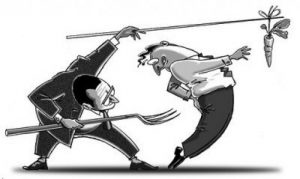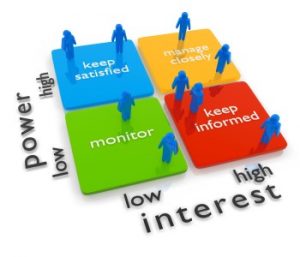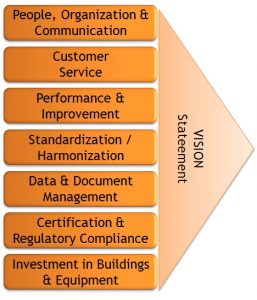Have Succesfully Create Sense of Urgency
 Do you have difficulties as a Quality Manager to convince your senior management to give priority to quality and food safety? Do you struggle to get engagement from the wider organization when it comes to seeing the importance of quality and displaying the right food safety behaviour? This is a daily situation a lot of quality and food safety managers find themselves in.
Do you have difficulties as a Quality Manager to convince your senior management to give priority to quality and food safety? Do you struggle to get engagement from the wider organization when it comes to seeing the importance of quality and displaying the right food safety behaviour? This is a daily situation a lot of quality and food safety managers find themselves in.
One of the bests ways to change this type of situations is to create a sense of urgency both at management level and in the organization. But the main question is how to do this in a way that does not upset senior management and does not place you in a situation to be seen as an overly concerned person who is not in touch with reality. Typically you will only get one chance to properly create a sense of urgency. If it does not succeed in the first run, you most likely will not be taken serious for a long while.
This article explains how to successfully create a sense of urgency for quality and food safety in five steps. By performing these steps in the order as discussed in this article you place yourself in the best possible position to succeed in creating a sense of urgency. It is important though to realize that you must follow-up with a good plan and sound execution of that plan in connection to this. If you fail to do so, you will potentially do a lot of harm to the organization and certainly to your credibility as a Quality and Food Safety Manager. This article therefor must be seen as part of a bigger picture to create impact and engagement in the organization for quality and food safety, please read our overview article as well: “ 7 Steps to be IMPACTFUL a Quality Manager”.
Choose the right strategy
In essence there are two ways to generate a sense of urgency, both at an individual level as well as on an organizational level. The first way is to show the benefit of a certain approach, the bigger the benefit, to bigger the sense of urgency (or wanting) in the individual or organization. The other option is to work with fear of an (acute) danger. The latter is usually the stronger of the two, but also the one that needs to used with more care. Sometimes it is even good to make a combination of both (benefit and fear) to create a maximum sense of urgency. Let’s discuss the three options.

The most elegant way to create a sense of urgency is to focus people on the benefits that a certain strategy or action will have on the organization or the individual. However, there is also a risk included in this: as soon as the benefit is perceived not to be there anymore (or to a lesser extent), the sense of urgency you have created this way might disappear rapidly. For this reason you must really be 100% on the benefits and also on the size, impact and duration of these benefits to ensure you stand a good chance to create a sense of urgency solely based on benefits.
When creating a sense of urgency based on fair or to put it more mildly potential future hazard to the company or an individual (from now on we will refer to organization only, but you can insert individual as well), it is paramount to be 100% sure that the (perceived) hazard is realistic. This means that the hazard could occur with a realistic certainty. Hence it is important to properly document the hazard and the likelihood and of course impact of the hazard. Most of the time you will need to convince others that the hazard is really there and also that the potential impact is realistic. In other words, most people having access to the detailed information in relation to the hazard would come to the same conclusion in terms of the potential risk to the organization.
The third option is to use a combination of both benefit and hazard related sense of urgency creation. This usually is the best option as it makes that the sender of the message is perceived to have looked at a topic or business areas from all angles. It is of course still important to ensure you prepare your case to a deep enough level as we will in the next section.
Sound preparation
As with any success, everything stands with a good preparation. This is most certainly true when it comes to creating a sense of urgency. As stated before, you will usually only get one chance to do it right (or make a mess of it). Hence, everything stands or falls with a sound preparation. Next to this it is important to take into consideration that most managers want to relate all their decisions to money.
So, one of the key topics to address in your preparation is of course the financial impact (benefits or profits and hazards or costs) to the organization. Next to this you need to be able to indicate your level of certainty and timing of the benefits to be achieved and the likelihood and impact of hazards to occur in the future. Hence a good place to start is your insight in the Cost of Non Quality. If you do not yet have a good insight into this, ensure you do this first. This overview of the items in Cost of Non Quality is a good starting point. If reduction of time consumption is one of the benefits you might want to use an Activity Analysis template for capturing the right information first.
As stated before next to the financial impact on the organization, you need to be really sure on the likelihood of hazards and the realistic timing of benefits to be achieved. In the next two sections we will explain two very good ways to get a good view on both by involving the right people in your wider preparation process. But you also want to come prepared to the discussions with these people. And a good start for both researching the potential benefits and the potential impact of the identified hazards is to brainstorm on the underlying mechanisms or building blocks. A simple but elegant technique you can use for this is creating a mind map and or use the 5-Why-Analysis as a tool to deeper investigate hazards and their impact.
Create allies
When creating a sense of urgency it is important to have some strong and influential allies first. The last situation you want to end up in is standing in front of your management team and have a lot of questions and criticism being thrown at you and finding yourself without any support from within the management team. For this reason you need to perform some stakeholder management up front.
 The best way to start is to map your stakeholders according the schedule shown here. In your preparation you must always involve stakeholders with high power in the organization, as these can make or break the message you are trying to get across. Next to this you want to include a selection of the stakeholders with high interest but low power as well, as these might help you get a more detailed insight in the benefits or impact of the hazards during your preparation process.
The best way to start is to map your stakeholders according the schedule shown here. In your preparation you must always involve stakeholders with high power in the organization, as these can make or break the message you are trying to get across. Next to this you want to include a selection of the stakeholders with high interest but low power as well, as these might help you get a more detailed insight in the benefits or impact of the hazards during your preparation process.
Before you start interviewing any stakeholders, always make sure to start with the most important stakeholder of all – your boss. If your line manager does not have a similar view or does not at least support the process of trying to create a sense of urgency in the organization, you better think twice. Sometimes you will have to be persistent and even go as high as the CEO or company owner if your boss really does not support you, but in such a case you want to make sure to have a wide group of stakeholders agreeing with you up front.
The next thing to do is perform stakeholder interviews where you are going to test whether the stakeholders see the same benefits and / or hazards as you do. You want to let them do the talking an listen very well to their arguments and insights. This will really help you shape your plan and sharpen your insights in terms of costs and benefits. If the stakeholder strongly agrees to your point of view, use this to your advantage and prior to bringing up the discussion in the management team have a second meeting with these stakeholders and show them your presentation. This way you can really sharpen your message and you most likely will get support from their side during the meeting when required.
Have a plan
Creating a sense of urgency without having a good plan to address the underlying issue(s) is of course pointless. So, you need to prepare a high-level plan upfront before the meeting with your management team. You also need to include the details of your high-level plan in the presentation. As stated before the stakeholder interviews are a very important step and tool to help you create the building blocks of your high level plan.
 The plan you want to create should encompass all area’s of the issue(s) you are trying to address and at the same time be realistic and achievable. It is often good to split the plan into bigger building blocks and within each building block create a view on the first and most important activities to employ in the coming year (starting at the time you seek approval for your plan). Here’s an example of a typical building block structure you can choose for a company-wide approach to improve quality and food safety.
The plan you want to create should encompass all area’s of the issue(s) you are trying to address and at the same time be realistic and achievable. It is often good to split the plan into bigger building blocks and within each building block create a view on the first and most important activities to employ in the coming year (starting at the time you seek approval for your plan). Here’s an example of a typical building block structure you can choose for a company-wide approach to improve quality and food safety.
Be sure to communicate at all times that your plan is not a project. In other words, most of the time you want to create a lasting change of direction for the company, a lasting change of behaviour and engagement in the organization. Hence your plan will need to be a multi-year approach which you are going to update 2-3 years from now. Of course you cannot present a comprehensive multi-year approach as part of your call for the sense of urgency, during this phase you must focus on the key topics and key deliverables for the first year only, still communicating that all is part of a bigger scheme, which will continue to exist.
Execute Sense of Urgency
Before setting into your management team meeting have a look at this presentation, it includes some strong examples from well-known companies in the field of quality and food safety. More-over it includes a comparison between the impact of a food safety related (consumer) fatality and a safety related (employee) fatality. Of course each fatality is a tragedy in itself, but what most companies fail to see is that a food safety related fatality might even bankrupt the company.
As stated before, you want to test your presentation with a few of the key stakeholders before performing your final presentation in the management team. This way you ensure yourself you will get the buy-in you need and also you can practice it a few times.
Make sure you keep the presentation crisp, do not use too many slides and long sentences on the slides – the audience must really be able to follow your line of thoughts and not start reading slides from the screen.
